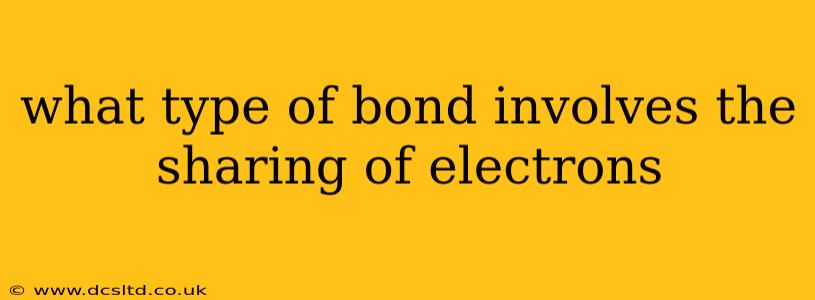What Type of Bond Involves the Sharing of Electrons?
A covalent bond involves the sharing of electrons between atoms. This sharing creates a strong attraction that holds the atoms together, forming a molecule. Unlike ionic bonds, where electrons are transferred from one atom to another, covalent bonds result from the mutual attraction of atoms to a shared pair of electrons. This shared electron pair resides between the bonded atoms, creating a stable electron configuration for each atom involved.
Let's delve deeper into the nuances of covalent bonding and address some common questions:
What are the different types of covalent bonds?
Covalent bonds aren't all created equal. There are several variations, categorized based on the number of shared electron pairs and the nature of the atoms involved:
- Single Covalent Bond: This is the most basic type, involving the sharing of one electron pair (two electrons) between two atoms. A classic example is the bond in a hydrogen molecule (H₂).
- Double Covalent Bond: Here, two pairs of electrons (four electrons) are shared between two atoms. Oxygen gas (O₂) is a prime example, with a double bond between the two oxygen atoms.
- Triple Covalent Bond: The strongest type of covalent bond involves three shared electron pairs (six electrons). Nitrogen gas (N₂) exhibits a triple bond between its nitrogen atoms.
- Polar Covalent Bond: In this case, the electrons are shared unequally between two atoms. This occurs when one atom is more electronegative than the other, meaning it has a stronger pull on the shared electrons. Water (H₂O) is a classic example, with the oxygen atom attracting the shared electrons more strongly than the hydrogen atoms, creating partial charges within the molecule.
- Nonpolar Covalent Bond: Here, the electrons are shared equally between two atoms. This typically happens when the atoms involved have similar electronegativities. A perfect example is the bond between two identical atoms, such as in the hydrogen molecule (H₂).
What is the difference between a covalent bond and an ionic bond?
The key difference lies in the transfer versus sharing of electrons.
-
Ionic bonds are formed when one atom transfers one or more electrons to another atom. This creates ions – positively charged cations (atoms that lost electrons) and negatively charged anions (atoms that gained electrons). The electrostatic attraction between these oppositely charged ions forms the ionic bond. Table salt (NaCl) is a classic example.
-
Covalent bonds, as discussed, involve the sharing of electrons between atoms. There's no complete transfer of electrons.
How do covalent bonds affect the properties of substances?
The nature of covalent bonds significantly impacts the properties of substances. Covalent compounds tend to:
- Have lower melting and boiling points than ionic compounds. This is because the weaker intermolecular forces between covalently bonded molecules require less energy to overcome.
- Be poor conductors of electricity. This is because, unlike ionic compounds that form charged ions in solution, most covalent compounds do not readily dissociate into ions.
- Often exist as gases, liquids, or low-melting-point solids at room temperature.
What are some examples of molecules formed by covalent bonds?
Covalent bonds are incredibly common in nature and form the basis of countless molecules, including:
- Water (H₂O): Essential for life, formed through polar covalent bonds.
- Carbon dioxide (CO₂): A greenhouse gas, formed through double covalent bonds.
- Glucose (C₆H₁₂O₆): A simple sugar, with numerous covalent bonds within its structure.
- Proteins and DNA: These complex molecules rely on a vast network of covalent bonds to maintain their structures and functions.
Understanding covalent bonding is fundamental to grasping the properties and behavior of a wide range of substances. From the air we breathe to the molecules that make up our bodies, the shared electron pair is a fundamental force shaping our world.
